《color purple》伟大的女性
浅析《紫色》中的女性主义(英文论文)

浅析《紫色》中的女性主义摘要:二十世纪美国黑人作家对美国文学的发展做出了不可磨灭的贡献,他们的作品极大地丰富了美国文学,同时也对世界文学的创作产生了巨大的影响。
进入七十年代以后,黑人女作家领导文学潮流,掀起了第三次美国黑人文学高潮。
艾丽丝•沃克是当代美国最杰出和最具影响力的黑人女性作家之一。
她对黑人命运问题的研究探讨,引起文坛瞩目,被认为是美国黑人作家中的后起之秀,有“女才子”之誉。
小说《紫色》是她文学创作的最高成就。
本文主旨意在分析《紫色》中的女性主义。
第一章简要地介绍了爱丽丝•沃克的个人经历及作品《紫色》。
第二章论文的理论基础—女性主义的含义和它的发展阶段。
第三章是本文的主体,以小说的主旨及其写作技巧—书信体形式两方面为切入点来分析《紫色》中所体现的女性主义。
最后本文得出女性如果要独立、自尊、自强,需通过自己不懈的努力,战胜重重困难,最终才能取得与男性平等的社会地位与权力的结论。
这也正是爱丽丝·沃克想要表达的女性主义的真正内涵。
关键词:《紫色》美国黑人女性女权主义双重压迫寻求独立An Analysis of Feminism in The Color PurpleLi YixuanAbstract: Afro—American writers have made great contribution to American literature in the 20th century. Their works have enormously enriched American literature and exerted great influence on literary creation in the world. Black women writers have set off a new upsurge of literature since the 1970s. This is called the third Renaissance of Afro—American literature. Alice Walker is one of the most remarkable and influential Afro—Americanwriters in contemporary American literary world. Her famous novel The Color Purple is the summit of her literary achievements. The thesis is intended to explore the Feminism in the novel The Color Purple. Chapter one gives a brief introduction to Alice Walker’s personal experience and her novel The Color Purple. Chapter two shows the theoretical foundation of the thesis—Feminism, the definition and the development of it. Chapter three, is the main body of the thesis, deals with the analysis of Feminism in this novel and its writing technique—epistolary style,use these two aspects as a starting point to analysis the feminist which embodied in this novel. The end of this paper which concluded if women want to gain independence, self—esteem and self—reliance, the only thing they can do is to try every effort and to overcome the numerous difficulties to gain these things. And finally they can get the social status and social rights which is equal to men. This is exactly what Alice Walker wants to express the true meaning of the Feminism.Keywords:The Color Purple; Afro—American women; Feminism; double oppression;independenceContents承诺保证书 (I)摘要 (II)Abstract (III)Introduction (1)I. A Brief Introduction of Alice Walker and Her Novel —The Color Purple (2)1.1 A Brief Introduction of Alice Walker (2)1.2 Alice Walker’s Literary Work—The Color Purple (3)II. Theoretical Foundation (5)2.1The Definition of Feminism (5)2.2The Development of Feminism (5)III. An Analysis of Feminism in the Novel—The Color Purple (8)3.1 The Theme of the Novel (8)3.1.1 Sex ual Oppression upon Black Women (8)3.1.2 Fighting for Independence (11)3.2 The Writing Technique and Rhetoric Method of the Novel (14)3.2.1 Epistolary Style (14)3.2.2 Metaphor (15)Conclusion (17)References (18)IntroductionThe Afro-American literature is one of the important parts of the American literature and it undergoes a very long development and different periods of development. In the earlier stage of the 20th century, Afro-American literature expresses the praise for black nationalities and the longings for equality and freedom. "Fictions of protest" by middle stage writers focus on the exposure of racism and the poverty of Afro-Americans and reveal the writers’anxiety about the American dream. In the later stage, female writers represented by Walker have been turned over a new leaf. This thesis is a brief analysis of Alice Walker and her famous work The Color Purple. In this novel Walker mainly discussed the contradiction between men and women. Disclose the oppression inside the black community. Though telling the story of Celie—an ordinary black woman in the southern village in American—from insensitive to bear the oppression from the black males to realize the reality and fright for herself. The author deeply disclose the life which Afro—American women were suffered and exquisite depicted the Celie’s sufferings. Use Walker’s words:This novel describes the emotion of social oppression and the spirit’s substances are all told by a black woman who suffered a frustrated life. While she—Celie finally found a way out. She finally found a job, got her friendship, her own love and dignity.” The great place of this novel is that it not only disclose the misery of Afro—American women, but also discussed how to help those women to get rid of the “the problem of recover oneself” traditionally.I. A Brief Introduction of Alice Walker and Her Novel —The Color Purple1.1 A Brief Introduction of Alice WalkerAlice Walker is one of the most important contemporary Afro—American women writers, born in 1944. She is a novelist, a short fiction writer, a poet, a critic all at once. She is the eighth child of a sharecropper family in Eatonton, Georgia, where the tenant farmer system kept most black families perpetually in debt. She always lived a very poor life and at that time education was not taken very seriously. But Walker’s mother insisted that her children should go to school. After her trying Walker started school at four years old and proved to be an excellent child.In 1961 Walker was awarded a scholarship to Spelman College, a small black women school in Atlanta. In the following years she was selected to attend the Youth World Peace Festival in Finland. It was also when she first heard about Dr. Marin Luther King in her freshman year at Spelman.In 1964, she transferred to Sarah Lawrence College in Bronxvile, New York where she majored in literature and has a deep study in Latin poetry and history. After graduating from Sarah Lawrence with a bachelor’s degree, Walker returned to the South and was actively to participate in the Civil Rights Movement. Her work in Georgia put her closely linked to the poorest and lowest educated Afro—Americans and allowed her to have an attention to the impact of poverty on the relationships between black men and women.In 1970, she wrote her first novel, The Third Life of George Copeland; her second collection of poems, Revolutionary Petunias and Other Poems (1973); her first short stories collection,In Love and Trouble: Stories of Black Women (1973). Walker became a leader of spokesperson for the black feminism.By 1979, her next novel began forming in her mind. She thought she must to write the novel in which the characters are trying to contact her, to speak through her. So she sold her house and moved to California, settling in the countryside of San Francisco, a place that “looked a lot like the town in Georgia most of the characters were from”. And there the things which in her mind came freely and the novel The Color Purple flowed.Alice Walker was a civil rights advocator and actively to take part in the Civil Rights Movement of the 1960’s. She was a spokeswoman for the women’s movement. The honors and awards which she gained include Bread Loaf Writers’ Conference Scholar in 1966, Merrill Writing Fellow in 1966—1967, the American Academy and Institute of Arts and Letters Rosenthal Award in 1974 for In Love and Trouble, the Pulitzer Prize and the American Book Award in 1982 for The Color Purple, and so on. She is claimed to be one of the most famous black women writers in the American literary history.1.2 Alice Walker’s Literary Work—The Color PurpleThe background of the novel is in a southern American village roughly between 1916 and 1942, a period during the status of blacks remained unaltered in the Deep South. The protagonist Celie suffered a miserable life, at first she keeps silent about what happened on her, but this doesn’t stop bad things happening on her. H er mother dies, her two children are taken away, leaving her alone wondering whether they have been sold or even killed. Celie is victimized physically and mentally by her father. Utterly alone and out of desperation, she has no choice but to write to God to express her sufferings and feelings.Celie lives like a slave. In fact, the life with Albert, her husband, is the continuous of her nightmare. In the wedding day, Harpo, the oldest son of Albert welcomes Celiewith a rock laying her head open and the blood runs. He tortured her. His dad tells him not to do that. And he rapes Celie with her head blooding. Actually, Albert marries Celie not for love, just because he is in need of a servant to take good care of his three children and Celie just fit this.To Celie, the most desperate thing is that she never gets love and care from her mother, instead, her mother who doesn’t know the truth always screams and torture her. After she dies, Nettie, the most intimate woman in Celie’s life, is separated from Celie by Mr. Albert. Since then, Celie gets no message from her and thought she has died. Reading through the old letters, Celie knows Mr. Albert’s evil deeds with Nettie and her family’s truth. S he knows that her father, who rapes her, isn’t her natural father; her natural father has been dead because he is succeeding in the financial business in the white business world. Celie is angered by all that God has allowed to happen to her. She writes her last letter to God retelling her sufferings and accusing God of being silence. She is totally desperate to what has happened on her.As Celie curses on Mr. Albert for what he has done to her, she finds something which she has never been aware of. She has learned that the quality of life must not depend on the outside world; to be survived; to find one’s value; is what color purple means for. Celie can surround herself in purple, for she is in control of Kingdom.II. Theoretical Foundation2.1 The Definition of FeminismFeminism refers to a major woman’s experiences as the source and motivation of social theory and political movement. Critique of social relations, many supporters of feminism also focus on the analysis of gender inequality and promote women's rights, interests and issues. It also refers to a social theory and political movement with the female experience for its source in the social relations outside criticism, many women socialist supporters also focuses on the analysis of the gender inequality and promote women's rights and interests issues of feminist theory aims to understand the nature of the inequality, emphasis on gender, political power relations and sex consciousness (sexuality) on the theme of feminist inquiry, including discrimination stereotype materialized (especially about sex and chemical) body housework distribution oppressions and the oppression form the patriarchy. And in my opinion, the Feminism which Alice Walker discussed has a deeper meaning. It is a comprehensive protest to all kinds of oppression system (sexual oppression and racial oppression).2.2 The Development of FeminismFeminism in the nineteenth century gradually changed to the organized social movement because more and more people believe that women in a patriarchal society should treated equally. The feminist movement is rooted in the Western progressive, especially the nineteenth Century reform movement.Early feminists and early feminist movement is often called the first wave, and after 1960 feminist called the second wave. There is also the so-called the third-wave, but feminists for its existence necessity, contribution and concept disagree. The reason why these periods are called is because they like the waves, one after another; never discontinuous, later used the former Walker's contribution and resources.The Western Feminism can be mainly divided into three generations:The first generation of Western Feminism: Western Feminism originated in France bourgeois revolution and enlightenment movement, the second half of the nineteenth Century the emergence of the first generation, and the industrial revolution in Europe, is the representative of the British Harriet Tyler Mill. French female writer Gore in 1790 issued a “Declaration on the Rights of Women”, 17 women's rights. Declaration later became a programmatic document of the feminist movement. M. Wollstonecraft, British writer, published a book “Defense for Women's Rights”, in 1792, proposed that women should enjoy equal treatment with men in education, employment and politics. Until 1920, the United States passed a bill to protect women the right to vote. The initial appeal of women in education and legislation should be equal. In the United States, Elizabeth Cady Stanton National Woman Suffrage Association represented (NWSA) repeatedly requested the federal Congress to allow women to participate in political polling repeatedly refused to encounter, eventually in the Nineteenth Amendment (1920). During this period, feminism is not elevated to the level of theory, is mainly a number of practical activities and “March 8. International Women's Day "was born.The second generation of Western Feminism: The second stage is the most important phase of feminism in the West stage. The feminists found that although the women in the field of political and economic fight for equality and efforts to achieve significant results, but the unequal status of women in social life has not been fundamentally improved. For example, groups of women get the right to vote in politics is still in a low position , occupational segregation and career development prospects of poor highlights, the case of equal pay for equal work , equal employment basically guaranteed. This contradiction prompted feminist thinking in depth, forming a unique feminist theory. From early 20th until 1960s, the world experienced two world wars. During this period, Afro—American woman still under the control of themale society. The challenge which they faced is the patriarchal society, challenges the "class" system.The third generation of Western Feminism: Postmodern Feminism.Postmodern Feminism began in the last century 60-80 age, her resulting presumably and two factors, one is, since 60's "liberation" and the men and women in opposition to the feminist thought, has brought numerous family breakdown, single mothers and the AIDS epidemic, so people began to reflect: especially in the elimination of binary opposition between men and women, forming “Gentle Feminist”, "Green Feminists”. While recognizing the achievements of the feminist movement to protect women's rights, it also questioned the other hand; feminists have tried to subvert the traditional family model. Post-modern feminism is still a growth stage. Trying to eliminate inequality between men and women on the basis of the recognition of gender differences, emphasizing the social nature of gender roles, the idea of equality between men and women as a product of patriarchy .Thus, postmodern feminist emerge as the times require.III. An Analysis of Feminism in the Novel—The Color Purple3.1 The Theme of the NovelThe color purple is a feminist Bildungsroman. It tells how Afro—American women find themselves and fight for themselves though describing the sufferings of what Celie had experienced.While revealing patriarchy’s oppression upon Afro—American women, feminists point out that while disclosing the oppressions, what Afro—American men done had consequently deepens Afro—American women’s suffering. As Hruston states in Their Eyes were Watching God: “So de white man throw down de load and tell de nigger man thus pick it up. He picks it up because he has to, but he doesn’t tote it. He hand it to his woman folks. De nigger woman is de mule of the worlds so far as ah can see.” Alice Walker tries to disclose these oppressions in her novels. In The Color Purple, Walker also shows us how racism exacerbates these oppressions in Afro—American family. Black feminist writers reveal racial, gender oppressions between the sexes to improve the gender binary opposition between men and women, longing for an ideal, gender relation.Throughout these oppressions that the Afro—American women suffers, the main oppressions were racial oppression and sexual oppression.3.1.1 Sexual Oppression upon Black WomenSexual oppression has a great influence to the Afro—American women. The black has consciously in the face of modern society of sexual discrimination. Compared with men, blac k women’s statuses are lower. Their marginalized status is not only caused by racial discrimination, but also from male social gender discrimination.Alice Walker writes: “Black women are called in the folklore that so aptly identifies one’s status in society ‘the mule of the world’, because we have been handed the burdens that everyone else refuse to carry.” In the Color Purple, the only choice for a girl like Nettie to make is “either to marry somebody like her husband or wind up in some white lady kitc hen.”(CP 1987:17) In a patriarchy society, women are the main labor force both at home and in the fields.Although black women are the main labor force of the black family, they have no rights they deserve. On the contrary, they are constantly beaten by their husband. Mr. X—Celie’s husband, instructs his son: “Wives is like children. You have o let them know who got the upper hand. Nothing can do better th an a good sound beating.”(CP 1997:34) Mr. X beats Celie “like her beat the children. Cept he cont eve r hardly beat them. He say, Celie, git the belt. The children be outside the room peeking through the crack…”(CP 1987:22) The men who exploit and oppress women are acting out what Diana E.H.Russell terms the “masculinity mystique”—“To win, to be superior, to conquer, and to control demonstrate masculinity to those who subscribe to common cultural notions of masculinity.” Since Harpo is confused by the perfect control that his father exerts over Celie, he feels less than a man because of his inability to control his wife Sofia. Following his father’s instruction, Harpo keeps on beat ing Sofia and this finally leads to their separation.Except for the heavy burden and physical hurts, black women are sexually abused. In black men’s eyes, black women are only t he instruments for them to release their bad mood. They just enjoy their own happiness and the only thing left for women is the untold sufferings.In the Color Purple, in order to control women under their power, black men constantly impose their own con cept upon black women. Celie has “always been a good girl.”(CP 1987:3) She is so good—natured even his stepfather has to admit that “she good with children… Never heard her say a hard word to one of them.”(CP1987:12) She selflessly helps to take care of Shug when she is seriously ill, although she is he r husband’s mistress; she is also a clever student in school praised by her teacher, she says that: “long as she been a teacher she never know nobody want to learn bad” as her. But her stepfather always abus es her. He introduces Celie to Mr. X : “She ain’t fresh… She spoiled. She ugly… She is too old to be living her at home. And she has a bad influence on my other girls… She ain’t smart either… And another thing—she tell lies.”(CP1987:10) In his eyes, Celie is “evil and always up to no good” and “he can’t stand” hr no more. (CP 1987:5)Shug is also a good woman. She follows one of the few professions open to black women: blues singer; she is independent economically by hard working; she safeguards her selfhood; she asserts her own value; she displays a wisdom learned in her working lives to teach the girls she loves not to allow others to use or revile their individuality and tells the men what she thinks of their weaknesses. One thing that we can figure out is that one of the strategies the black men employ to take women under their control is to decry their reputation and deprive them of their confidence. They try all the means to let the women believe that they themselves are bad in nature and inborn, so they deserve any kind of ill—treatments black men exert on them.In Africa, men, even some women, don’ think girl need to be educated. When Nettie asks a mother why she thinks so, she said, “A girl is nothing to herself, only to hr husband can she become s omething.”(CP 1987:132) When Tashi, a little girlfriend of Olivia, Celie’s daughter in Africa, learns some knowledge from Olivia and becomes quiet and thoughtful, her patents even get upset for being afraid that she will not fit into village life. In addition, women are deprived of the right to choose the ways of their lives from their own free will. In the novel, it is Celie’s stepfather who chooses husband for Celie. He is her owner. In a scene reminiscent of a slave action, Celie is passed like a piece of property from one creel and domineering black male into the hands of another:The Color Purple is to expose the double oppression endured by the black women so that the solution to this problem existing in the black community can push forward the develo pment of black people’s unity. The most significant for Alice Walker is that she advances her tentative solution—feminism in the hope of curing the social diseases of racism and sexism and promoting the development of society.Walker through the description of a black woman seeking her dual identity reveals to us that only if black women in the United States integrated black blood, do the masters of their own destiny, he creates his own, can they get rid of edge position, and obtain their own identity.3.1.2 Fighting for IndependenceAlthough the Afro—American women under the control of the patriarchal social, they never give up struggling for their own independence. Their independence can be discussed mainly from these two aspects: familial independence and social independence.In the patriarchal family, women are the labor force both inside the house and outside in the field. However they didn’t get what they deserve to get, such as equality, love and respect. On the contrary, they suffered pain and mental torture. What they had experienced also sowed the seeds for the future of their resistance.Social independence implies black women’s independence in the society, including economical and political independence. In America, many Afro—American women have to depend on black men mainly due to their main status in economy. They are generally degraded to objects and became the secondary gender in the society. So exploration for social independence is very significant for black women to change their social status. In the Color Purple, the feminist explores to gain social independence mainly by using the Afro—American woman’s potential ability, whichalso discloses the feministic viewpoint—to make full use of black women’s strong viewpoints and realizing the importance of gaining their own social independence.Number one is Celie’s self-identity and women's socialist mental health.Identity, is one of the major contents in western literary criticism, it advocates accented literature classic, the thorough analysis colonial hegemony and male central cultural rewriting history between men and women in colonial conflict story.If Celie continue to maintain a callous life, resigned, muddy disturbance to spend her life go, then, then the characters will fall into the traditional literature's misconduct. However, Walker doesn’t want to fall into formality. She, in an interview said: "people not only to live, to prosperity but also to love life. She gave her life to the love and life " Live unremitting pursuit, pour into to literary works, Celie from decayed traditional thought to emancipate herself, helped herself to set up the life of optimism attitude, to break the traditional literature in the description of black women "" False image, namely and the reality of black women did not fit with the image, Shaping a new black women's image.Number two is Celie’s exploration: from the rebellious to rebirth.In Ceie’s mind God is omniscient and omnipotent. After these sufferings, God is the only listener and savior to her, however, after sent 55 letters to God and without any answers back to her, Celie could no longer bear it, she even said: “ What did God do for me?—He is a big devil, his behavior is just like any other man I know: frivolous, forgetful and contemptible.” This sentence represents the first leap of her character’s development. She not only challenges the authority of God’s but also challenges the patriarchy’s thought.Independent women, who run away from her family and then return to it again, will have a different feeling. After the success, she forgives her husband whom once abused her, and then they become very good friends. Although she don’t want to rebuild her family, but in her opinion, her husband was not as disgusting as before. Her concern about personal destiny cares about group destiny, from the thinking about the individual value, personal survival significance to all mankind pain and liberation exploration. She stood at the height of the human life, overlooking human life and rethinks the life. This humanity spirit and highly responsibility really make us to rethink on and take example by.Number three is from Celie’s heart journey to see Walker’s women socialist connotationCelie’s self identity and women's socialist spirit is meaningful; it ha s the ideal womanism of the author. The Color Purple describes a group of black women whom representative is Celie, they pursue for equal rights and personal identity, struggle to enlarge the attention range. Walker wrote the black woman whom in the lowest social level, what’s more important, on the basis of racial and sexual oppression; Walker added to the natural element and combines them together. Committed to achieve interpersonal, man and natural’s harmonious survival mode.Moreover, Celie's tolerant and mind is universal love is what Walker’s Socialist soul places. In the process of difficult self-identity construction, pursue women's spirit use the spirit of tolerance to forgive those black men who had abused them; Black male also abandoned the original great man's doctrine thought, through the self-improvement, they not only realize the spirit of their own survival, but also promoted other characters in the novel (especially the female character) complete live, thus bring the black community to a rebirth.In economy, the womanist quests for self—realization form black feminine household activities, which are usually belittled by black males or even females themselves by relating to revelations of black women as the weak sex in the society. The womanist realizes her limitless potential as a black woman in her daily work—the wisdom and artistic creativity, by which she gains self—confidence and self—support, and thus actualizes her independence in the society.In culture, the womanist quests for social independence by her own black feminine tradition. She persists in presenting her creative artistic charm as a black woman, in her feminine creative activities, such as quilting, designing nd making pants. While questing for black woman’s beauty and dign ity in these artistic activities, she gets her cultural independence. Moreover, Celie sticks to speaking her native language instead of the Standard English, which also indicates her persistent exploration for her own cultural tradition and her cultural independence.At the end of the novel, Celie achieves great economical success; she sets up her own company to produce all kinds of pants designed by her. By making pants, Celie creates a new way to make her living and completely frees herself from subordinate status in economy and realizes her self—independence in the society. She is no longer the oppressed, exploitative, abusive object. She can say what she wants to say. She founded her female subjectivity, and eventually became the woman who has full of confidence, dignity, and personality. From the reverse to stand on her own, Celie produced very big change, after awakening has more strong resistance. She insisted on using their own language to express them, express her anger, her joy and her song.3.2 The Writing Technique and Rhetoric Method of the Novel3.2.1 Epistolary StyleEpistolary novel is a type of novel in which the author is carry on by means of series of letters. It is a traditional feminine genre associated with women’s voice, feelings。
爱丽丝·沃克《紫颜色》中的黑人女性形象

· 69 ·作家作品论【摘 要】爱丽丝·沃克是20世纪70年代美国女性主义文学的代表,她被称作黑人女权主义的代言人。
她的小说以描写生活在美国社会最底层以及全世界黑人妇女的悲惨命运为主要内容。
在小说中塑造了多种女性形象,这些形象有别于传统文学中塑造的自卑、丑陋的固化形象。
在沃克的笔下,黑人女性从单纯、愚昧逐渐转变为追求独立价值与自我人格,不仅摆脱被压迫、被剥削,而且在精神上实现自我解放。
【关键词】爱丽丝·沃克 女性主义 《紫颜色》爱丽丝·沃克《紫颜色》中的黑人女性形象苏虹蕾爱丽丝·沃克是20世纪70年代美国女性主义文学的代表,她被称作黑人女权主义的代言人。
她的小说以描写生活在美国社会最底层以及全世界黑人妇女的悲惨命运为主要内容。
这部分创作灵感很大一部分来自沃克的童年生活经历。
沃克出20世纪40年代出生在美国南方的一个贫穷的农民家庭,在她之前家里已经有七个孩子。
在一次意外中沃克的右眼被射瞎,自卑的沃克只能拼命读书来填补内心的寂寞与孤独,为日后的文学创作积淀了大量的素材。
之后,沃克顺利地进入大学学习,积极投身于妇女解放运动和争取种族平等的运动中去,将自己全部的精力致力于黑人女性所面临的种种问题上。
沃克陆续创作了《紫色》《格兰治·柯普兰之三生》等多部小说。
《紫颜色》的发表使沃克声名鹊起,为世界范围内的读者所熟知。
这部小说在发表之后一举斩获了美国普利策文学奖项,并被改编成电影搬上大银幕,成为美国女性主义文学上一件里程碑式的事件。
在小说《紫颜色》中沃克塑造了多种女性形象,这些形象有别于传统文学中塑造的自卑、丑陋的固化形象。
在沃克的笔下,黑人女性从单纯、愚昧逐渐转变为追求独立价值与自我人格,不仅摆脱被压迫、被剥削,而且在精神上实现自我解放。
本文试图将《紫颜色》中塑造的女性形象进行分类,从多个角度和层次来分析这些形象,加深对沃克小说社会内涵和文化意蕴的理解。
The Color Purple《紫色》—影片视听语言浅析
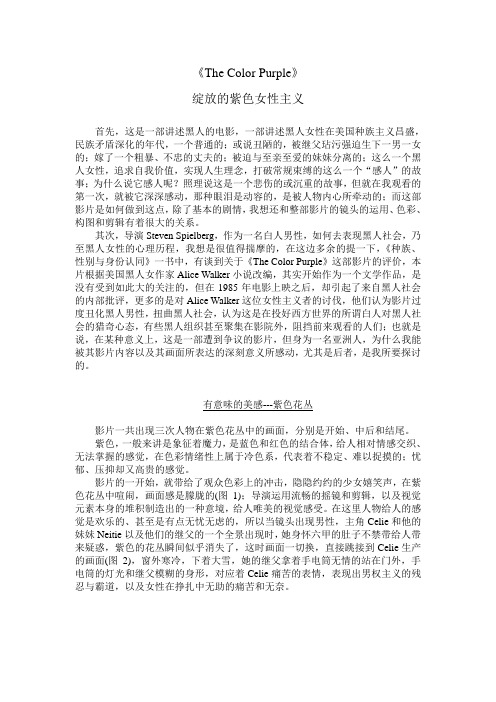
《The Color Purple》绽放的紫色女性主义首先,这是一部讲述黑人的电影,一部讲述黑人女性在美国种族主义昌盛,民族矛盾深化的年代,一个普通的;或说丑陋的,被继父玷污强迫生下一男一女的;嫁了一个粗暴、不忠的丈夫的;被迫与至亲至爱的妹妹分离的;这么一个黑人女性,追求自我价值,实现人生理念,打破常规束缚的这么一个“感人”的故事;为什么说它感人呢?照理说这是一个悲伤的或沉重的故事,但就在我观看的第一次,就被它深深感动,那种眼泪是动容的,是被人物内心所牵动的;而这部影片是如何做到这点,除了基本的剧情,我想还和整部影片的镜头的运用、色彩、构图和剪辑有着很大的关系。
其次,导演Steven Spielberg,作为一名白人男性,如何去表现黑人社会,乃至黑人女性的心理历程,我想是很值得揣摩的,在这边多余的提一下,《种族、性别与身份认同》一书中,有谈到关于《The Color Purple》这部影片的评价,本片根据美国黑人女作家Alice Walker小说改编,其实开始作为一个文学作品,是没有受到如此大的关注的,但在1985年电影上映之后,却引起了来自黑人社会的内部批评,更多的是对Alice Walker这位女性主义者的讨伐,他们认为影片过度丑化黑人男性,扭曲黑人社会,认为这是在投好西方世界的所谓白人对黑人社会的猎奇心态,有些黑人组织甚至聚集在影院外,阻挡前来观看的人们;也就是说,在某种意义上,这是一部遭到争议的影片,但身为一名亚洲人,为什么我能被其影片内容以及其画面所表达的深刻意义所感动,尤其是后者,是我所要探讨的。
有意味的美感---紫色花丛影片一共出现三次人物在紫色花丛中的画面,分别是开始、中后和结尾。
紫色,一般来讲是象征着魔力,是蓝色和红色的结合体,给人相对情感交织、无法掌握的感觉,在色彩情绪性上属于冷色系,代表着不稳定、难以捉摸的;忧郁、压抑却又高贵的感觉。
影片的一开始,就带给了观众色彩上的冲击,隐隐约约的少女嬉笑声,在紫色花丛中喧闹,画面感是朦胧的(图1);导演运用流畅的摇镜和剪辑,以及视觉元素本身的堆积制造出的一种意境,给人唯美的视觉感受。
试析《紫色》中的女性主义
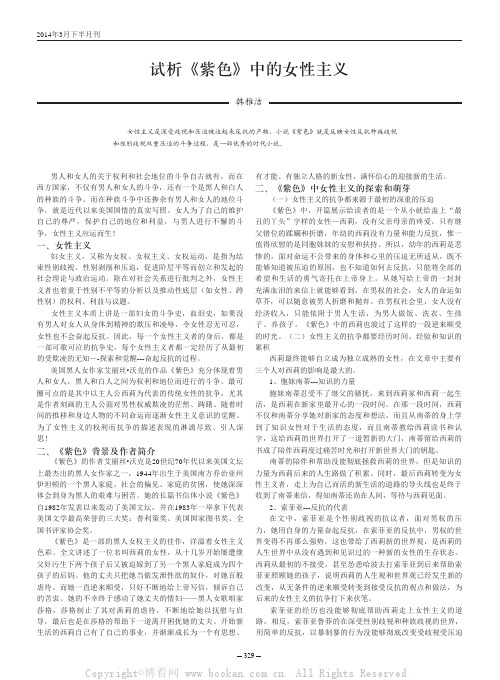
3292014年3月下半月刊艺术文化交流男人和女人的关于权利和社会地位的斗争自古就有,而在西方国家,不仅有男人和女人的斗争,还有一个是黑人和白人的种族的斗争。
而在种族斗争中还掺杂有男人和女人的地位斗争,就是近代以来美国国情的真实写照。
女人为了自己的维护自己的尊严,保护自己的地位和利益,与男人进行不懈的斗争,女性主义应运而生!一、女性主义妇女主义,又称为女权、女权主义、女权运动,是指为结束性别歧视、性别剥削和压迫,促进阶层平等而创立和发起的社会理论与政治运动。
除在对社会关系进行批判之外,女性主义者也着重于性别不平等的分析以及推动性底层(如女性、跨性别)的权利、利益与议题。
女性主义本质上讲是一部妇女的斗争史,血泪史,如果没有男人对女人从身体到精神的欺压和凌辱,令女性忍无可忍,女性也不会奋起反抗。
因此,每一个女性主义者的身后,都是一部可歌可泣的抗争史,每个女性主义者都一定经历了从最初的受欺凌的无知—-探索和觉醒---奋起反抗的过程。
美国黑人女作家艾丽丝•沃克的作品《紫色》充分体现着男人和女人,黑人和白人之间为权利和地位而进行的斗争。
最可圈可点的是其中以主人公西莉为代表的传统女性的抗争,尤其是作者刻画的主人公面对男性权威欺凌的茫然、踌躇、随着时间的推移和身边人物的不同命运而逐渐女性主义意识的觉醒、为了女性主义的权利而抗争的描述表现的淋漓尽致、引人深思!二、《紫色》背景及作者简介《紫色》的作者艾丽丝•沃克是20世纪70年代以来美国文坛上最杰出的黑人女作家之一,1944年出生于美国南方乔治亚州伊坦顿的一个黑人家庭。
社会的偏见、家庭的贫困,使她深深体会到身为黑人的艰难与困苦。
她的长篇书信体小说《紫色》自1982年发表以来轰动了美国文坛,并在1983年一举拿下代表美国文学最高荣誉的三大奖:普利策奖、美国国家图书奖、全国书评家协会奖。
《紫色》是一部的黑人女权主义的佳作,洋溢着女性主义色彩。
全文讲述了一位名叫西莉的女性,从十几岁开始屡遭继父奸污生下两个孩子后又被迫嫁到了另一个黑人家庭成为四个孩子的后妈。
好莱坞电影中的黑人女性解读

好莱坞电影中的黑人女性解读随着社会的进步与发展,电影文化界越来越关注有色女性的生活状态,研究和探讨有色女性在社会中所遭受到的歧视和压迫,追寻造成这种社会现象的原因,试图寻找解决这种现状的方法。
美国作为一个移民国家,有色人种占了很大的比例,由于历史以及社会文化等原因,美国的种族问题一直都存在,因此作为世界电影工厂的好莱坞将镜头对准了美国的黑人女性,了解她们的生活状态,探索黑人女性所处的尴尬境地,试图将黑人女性的心声真实地还原在电影之中。
本文以好莱坞电影《紫色》和《彩虹艳尽半边天》两部著名的黑人女性题材电影作为分析对象,解读好莱坞电影中的黑人女性形象。
一、《紫色》中的黑人女性解读《紫色》是美国杰出黑人女性作家艾丽丝沃克的代表作,其中描写了大量黑人女性的真实生活场景。
其同名电影《紫色》由著名导演斯皮尔伯格根据原著改编而成。
电影主要通过描写茜莉、索菲亚、秀格等黑人女性反抗的一生,来表现黑人女性对于政治、经济、性别权利平等的追求和为之进行的抗争及努力。
在不懈的权利追求和斗争中,几位黑人女性表现出了不同的性格特征。
在电影《紫色》中,茜莉是一名外表丑陋的黑人女性。
她身世可怜,被继父卖给亚伯特。
在继父眼里,茜莉是一个勤劳、能干、踏实肯学的女孩,但是性格中也充满着软弱。
在与亚伯特一起的生活中,茜莉不善言辞,并常常因此遭到亚伯特的嘲笑。
茜莉后来结识了歌手秀格,这成为茜莉命运的转折点。
在歌手秀格的影响下,茜莉的女性意识开始觉醒,并且开始追求自由独立。
受到启蒙运动影响的茜莉在聚餐时一改逆来顺受的处世风格,开始诅咒残暴的亚伯特。
亚伯特试图用经济来牵制茜莉,但是此时的茜莉已经懂得了自由和平等的重要性,坚定自己离开痛苦家庭的决心,从而走向独立。
走出家庭的茜莉在经济上获得了独立,在社会的磨砺中变得坚强和自信,最终摆脱了苦难的命运,成为一名获得自由的女性。
索菲亚在电影《紫色》中是茜莉养子的妻子。
索菲亚有着鲜明的个性和强大的气场。
从弗洛伊德人格结构角度解析《紫颜色》中西莉的成长
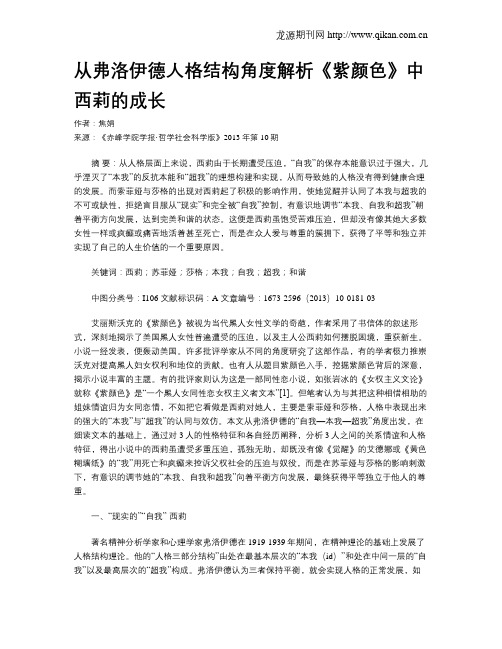
从弗洛伊德人格结构角度解析《紫颜色》中西莉的成长作者:焦娟来源:《赤峰学院学报·哲学社会科学版》2013年第10期摘要:从人格层面上来说,西莉由于长期遭受压迫,“自我”的保存本能意识过于强大,几乎湮灭了“本我”的反抗本能和“超我”的理想构建和实现,从而导致她的人格没有得到健康合理的发展。
而索菲娅与莎格的出现对西莉起了积极的影响作用,使她觉醒并认同了本我与超我的不可或缺性,拒绝盲目服从“现实”和完全被“自我”控制,有意识地调节“本我、自我和超我”朝着平衡方向发展,达到完美和谐的状态。
这便是西莉虽饱受苦难压迫,但却没有像其她大多数女性一样或疯癫或痛苦地活着甚至死亡,而是在众人爱与尊重的簇拥下,获得了平等和独立并实现了自己的人生价值的一个重要原因。
关键词:西莉;苏菲娅;莎格;本我;自我;超我;和谐中图分类号:I106 文献标识码:A 文章编号:1673-2596(2013)10-0181-03艾丽斯沃克的《紫颜色》被视为当代黑人女性文学的奇葩,作者采用了书信体的叙述形式,深刻地揭示了美国黑人女性普遍遭受的压迫,以及主人公西莉如何摆脱困境,重获新生。
小说一经发表,便轰动美国。
许多批评学家从不同的角度研究了这部作品,有的学者极力推崇沃克对提高黑人妇女权利和地位的贡献。
也有人从题目紫颜色入手,挖掘紫颜色背后的深意,揭示小说丰富的主题。
有的批评家则认为这是一部同性恋小说,如张岩冰的《女权主义文论》就称《紫颜色》是“一个黑人女同性恋女权主义者文本”[1]。
但笔者认为与其把这种相惜相助的姐妹情谊归为女同恋情,不如把它看做是西莉对她人,主要是索菲娅和莎格,人格中表现出来的强大的“本我”与“超我”的认同与效仿。
本文从弗洛伊德的“自我—本我—超我”角度出发,在细读文本的基础上,通过对3人的性格特征和各自经历阐释,分析3人之间的关系情谊和人格特征,得出小说中的西莉虽遭受多重压迫,孤独无助,却既没有像《觉醒》的艾德娜或《黄色糊墙纸》的“我”用死亡和疯癫来控诉父权社会的压迫与奴役,而是在苏菲娅与莎格的影响刺激下,有意识的调节她的“本我、自我和超我”向着平衡方向发展,最终获得平等独立于他人的尊重。
翻译TheColorPurplebyAliceWalker
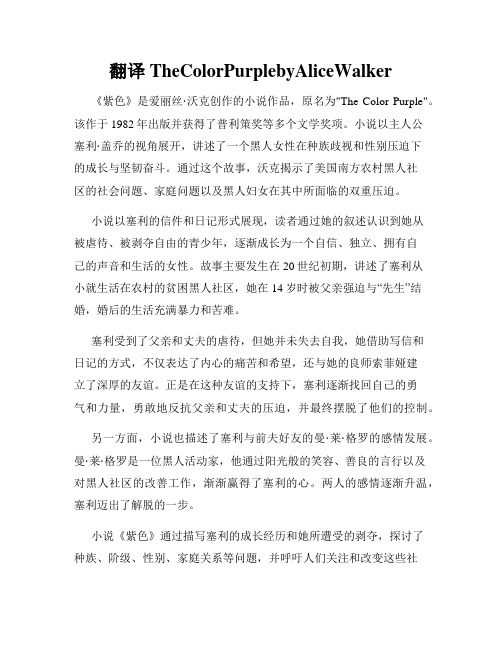
翻译TheColorPurplebyAliceWalker 《紫色》是爱丽丝·沃克创作的小说作品,原名为"The Color Purple"。
该作于1982年出版并获得了普利策奖等多个文学奖项。
小说以主人公塞利·盖乔的视角展开,讲述了一个黑人女性在种族歧视和性别压迫下的成长与坚韧奋斗。
通过这个故事,沃克揭示了美国南方农村黑人社区的社会问题、家庭问题以及黑人妇女在其中所面临的双重压迫。
小说以塞利的信件和日记形式展现,读者通过她的叙述认识到她从被虐待、被剥夺自由的青少年,逐渐成长为一个自信、独立、拥有自己的声音和生活的女性。
故事主要发生在20世纪初期,讲述了塞利从小就生活在农村的贫困黑人社区,她在14岁时被父亲强迫与“先生”结婚,婚后的生活充满暴力和苦难。
塞利受到了父亲和丈夫的虐待,但她并未失去自我,她借助写信和日记的方式,不仅表达了内心的痛苦和希望,还与她的良师索菲娅建立了深厚的友谊。
正是在这种友谊的支持下,塞利逐渐找回自己的勇气和力量,勇敢地反抗父亲和丈夫的压迫,并最终摆脱了他们的控制。
另一方面,小说也描述了塞利与前夫好友的曼·莱·格罗的感情发展。
曼·莱·格罗是一位黑人活动家,他通过阳光般的笑容、善良的言行以及对黑人社区的改善工作,渐渐赢得了塞利的心。
两人的感情逐渐升温,塞利迈出了解脱的一步。
小说《紫色》通过描写塞利的成长经历和她所遭受的剥夺,探讨了种族、阶级、性别、家庭关系等问题,并呼吁人们关注和改变这些社会问题。
故事中的塞利象征着黑人妇女的独立和坚韧,她们经历了一系列斗争和磨难,最终实现了内心的自由和解放。
沃克通过细腻的笔触和独特的叙述方式,引导读者思考种族和性别之间的交叉问题,以及社会的不公和压迫对个体生命的摧残。
小说并没有给出简单的答案和解决方案,而是通过对塞利等人的塑造和生活经历的描绘,希望唤醒读者对这些问题的思考和关注。
_紫色_中茜莉的_身体救赎_马春丽
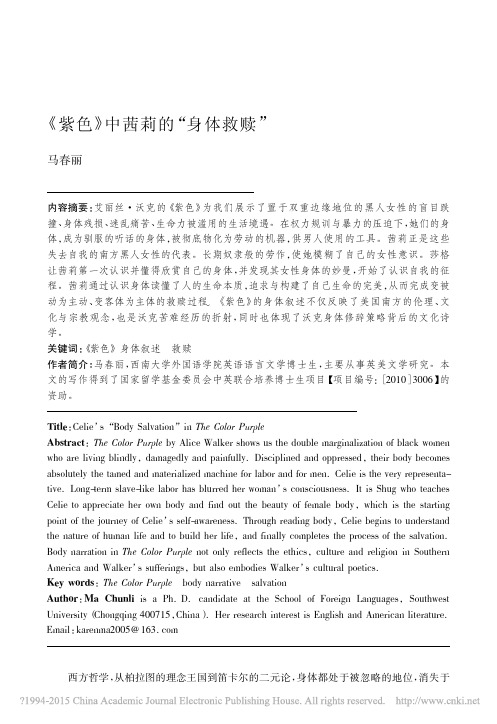
《紫色》中茜莉的“身体救赎”马春丽内容摘要:艾丽丝·沃克的《紫色》为我们展示了置于双重边缘地位的黑人女性的盲目跌撞、身体残损、迷乱痛苦、生命力被滥用的生活境遇。
在权力规训与暴力的压迫下,她们的身体,成为驯服的听话的身体,被彻底物化为劳动的机器,供男人使用的工具。
茜莉正是这些失去自我的南方黑人女性的代表。
长期奴隶般的劳作,使她模糊了自己的女性意识。
莎格让茜莉第一次认识并懂得欣赏自己的身体,并发现其女性身体的妙曼,开始了认识自我的征程。
茜莉通过认识身体读懂了人的生命本质,追求与构建了自己生命的完美,从而完成变被动为主动、变客体为主体的救赎过程。
《紫色》的身体叙述不仅反映了美国南方的伦理、文化与宗教观念,也是沃克苦难经历的折射,同时也体现了沃克身体修辞策略背后的文化诗学。
关键词:《紫色》身体叙述救赎作者简介:马春丽,西南大学外国语学院英语语言文学博士生,主要从事英美文学研究。
本文的写作得到了国家留学基金委员会中英联合培养博士生项目【项目编号:[2010]3006】的资助。
Title:Celie’s“Body Salvation”in The Color PurpleAbstract:The Color Purple by Alice Walker shows us the double marginalization of black women who are living blindly,damagedly and painfully.Disciplined and oppressed,their body becomes absolutely the tamed and materialized machine for labor and for men.Celie is the very representa-tive.Long-term slave-like labor has blurred her woman’s consciousness.It is Shug who teaches Celie to appreciate her own body and find out the beauty of female body,which is the starting point of the journey of Celie’s self-awareness.Through reading body,Celie begins to understand the nature of human life and to build her life,and finally completes the process of the salvation.Body narration in The Color Purple not only reflects the ethics,culture and religion in Southern America and Walker’s sufferings,but also embodies Walker’s cultural poetics.Key words:The Color Purple body narrative salvationAuthor:Ma Chunli is a Ph.D.candidate at the School of Foreign Languages,Southwest University(Chongqing400715,China).Her research interest is English and American literature.Email:karenma2005@163.com西方哲学,从柏拉图的理念王国到笛卡尔的二元论,身体都处于被忽略的地位,消失于611外国文学研究2012年第2期对心灵与理性的探索之中。
彩色篱笆读后感五百字
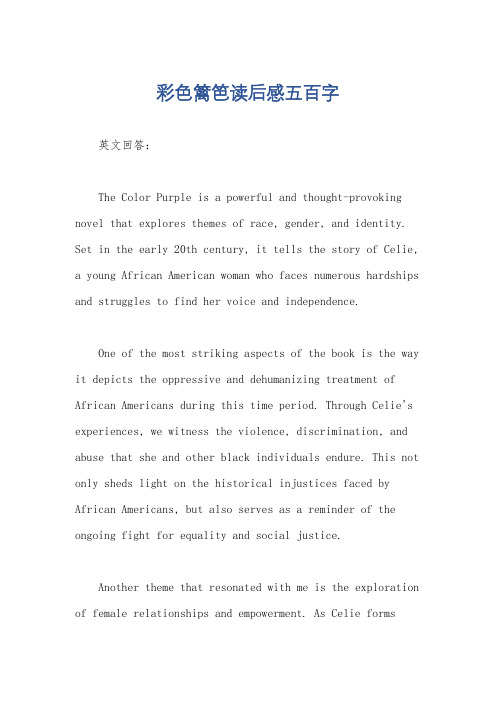
彩色篱笆读后感五百字英文回答:The Color Purple is a powerful and thought-provoking novel that explores themes of race, gender, and identity. Set in the early 20th century, it tells the story of Celie, a young African American woman who faces numerous hardships and struggles to find her voice and independence.One of the most striking aspects of the book is the way it depicts the oppressive and dehumanizing treatment of African Americans during this time period. Through Celie's experiences, we witness the violence, discrimination, and abuse that she and other black individuals endure. This not only sheds light on the historical injustices faced by African Americans, but also serves as a reminder of the ongoing fight for equality and social justice.Another theme that resonated with me is the exploration of female relationships and empowerment. As Celie formsdeep connections with other women, such as her sister Nettie and her friend Shug Avery, she begins to discover her own worth and strength. These relationships provide a sense of support and solidarity, showing the power of female bonds in overcoming adversity.Furthermore, the novel delves into the complexities of identity and self-discovery. Celie's journey towards self-acceptance and self-love is a central focus of the story. Through her experiences, we see the importance of embracing one's true self and rejecting societal expectations and norms.Overall, The Color Purple is a beautifully written and emotionally charged novel that tackles important social issues. It is a testament to the resilience of the human spirit and the power of love and friendship. Through its vivid characters and poignant storytelling, it leaves a lasting impact and encourages readers to reflect on their own beliefs and values.中文回答:《彩色篱笆》是一部强大而发人深省的小说,探讨了种族、性别和身份等主题。
从妇女主义的角度解析《紫色》这本毕业
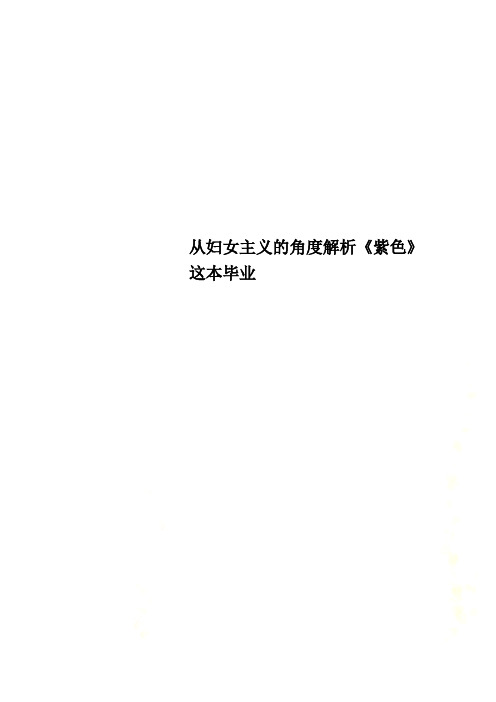
从妇女主义的角度解析《紫色》这本毕业X X 师范学院毕业论文An Analysis of The Color Purple from the Perspectiveof Wamanism从妇女主义的角度解析《紫色》这本书外国语学院英语教育专业 09 级 1 班学生姓名黄XX 学号 090201013指导教师丁XX 职称教授完成日期 2013年3月15日Abstract: Alice Walker is not only the first black woman writer in American history who won the Pulitzer Prize,but also is one of the most influential writers of contemporary American literature. Her novel The Color Purple is known as a timeless classic, which directly explores the contradictions and conflicts between black men and women, describes the hard course of black women’s growth, points out a feasible road of two sexes’ harmony, and further shows the e ssence of the “w omanism”.This thesis is divided into five parts. The first part gives a brief overview of Alice Walker and her masterpiece The Color Purple. The second part deals with the theoretical framework, and includes the theory of womanism. The third part gives an analysis of the four female characters in the Color Purple from the perspective of womanism. The forth part mainly deals with three unique features of womanist reflected in The Color Purple. Then naturally the fifth part makes a conclu sion. In all, Alice Walker‘s womannism overcomes the shortcomings of the feminism and provides a new angle of view to liberate black women.Key Words: Alice Walker; womanism; The Color Purple; Harmony【摘要】艾丽丝·沃克是美国历史上第一位获得普利策文学奖的黑人女作家,也是当代美国文坛最有影响的作家之一。
alice walker简介
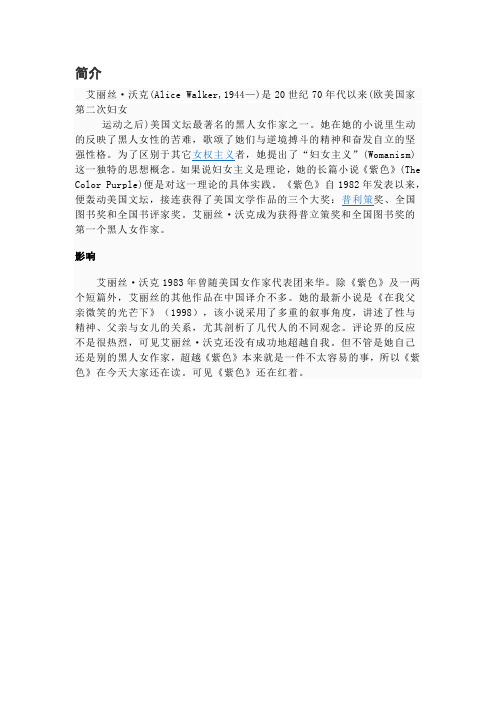
简介
艾丽丝·沃克(Alice Walker,1944—)是20世纪70年代以来(欧美国家第二次妇女
运动之后)美国文坛最著名的黑人女作家之一。
她在她的小说里生动的反映了黑人女性的苦难,歌颂了她们与逆境搏斗的精神和奋发自立的坚强性格。
为了区别于其它女权主义者,她提出了“妇女主义”(Womanism)这一独特的思想概念。
如果说妇女主义是理论,她的长篇小说《紫色》(The Color Purple)便是对这一理论的具体实践。
《紫色》自1982年发表以来,便轰动美国文坛,接连获得了美国文学作品的三个大奖:普利策奖、全国图书奖和全国书评家奖。
艾丽丝·沃克成为获得普立策奖和全国图书奖的第一个黑人女作家。
影响
艾丽丝·沃克1983年曾随美国女作家代表团来华。
除《紫色》及一两个短篇外,艾丽丝的其他作品在中国译介不多。
她的最新小说是《在我父亲微笑的光芒下》(1998),该小说采用了多重的叙事角度,讲述了性与精神、父亲与女儿的关系,尤其剖析了几代人的不同观念。
评论界的反应不是很热烈,可见艾丽丝·沃克还没有成功地超越自我。
但不管是她自己还是别的黑人女作家,超越《紫色》本来就是一件不太容易的事,所以《紫色》在今天大家还在读。
可见《紫色》还在红着。
英语论文艾丽斯·沃克《紫色》浅析
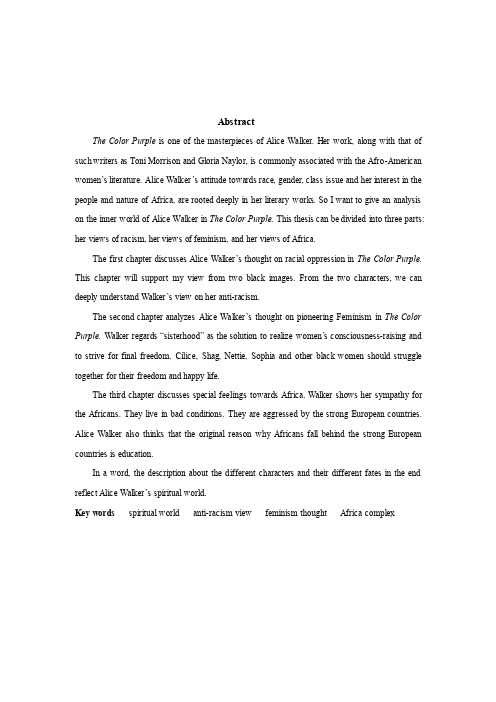
AbstractThe Color Purple is one of the masterpieces of Alice Walker. Her work, along with that of such writers as Toni Morrison and Gloria Naylor, is commonly associated with the Afro-American women‟s literature. Alice Walker‟s attitude towards race, gender, class issue and her interest in the people and nature of Africa, are rooted deeply in her literary works. So I want to give an analysis on the inner world of Alice Walker in The Color Purple. This thesis can be divided into three parts: her views of racism, her views of feminism, and her views of Africa.The first chapter discusses Alice Walker‟s thought on racial oppression in The Color Purple. This chapter will support my view from two black images. From the two characters, we can deeply understand Walker‟s view on her anti-racism.The second chapter analyzes Alice Walker‟s thought on pioneering Feminism in The Color Purple. Walker regards “sisterhood” as the solution to realize women‟s consciousness-raising and to strive for final freedom. Cilice, Shag, Nettie, Sophia and other black women should struggle together for their freedom and happy life.The third chapter discusses special feelings towards Africa. Walker shows her sympathy for the Africans. They live in bad conditions. They are aggressed by the strong European countries. Alice Walker also thinks that the original reason why Africans fall behind the strong European countries is education.In a word, the description about the different characters and their different fates in the end refle ct Alice Walker‟s spiritual world.Key words spiritual world anti-racism view feminism thought Africa complex摘要《紫色》是艾丽斯·沃克的代表作。
好莱坞电影中的黑人女性解读_646

好莱坞电影中的黑人女性解读随着社会的进步与发展,电影文化界越来越关注有色女性的生活状态,研究和探讨有色女性在社会中所遭受到的歧视和压迫,追寻造成这种社会现象的原因,试图寻找解决这种现状的方法。
美国作为一个移民国家,有色人种占了很大的比例,由于历史以及社会文化等原因,美国的种族问题一直都存在,因此作为世界电影工厂的好莱坞将镜头对准了美国的黑人女性,了解她们的生活状态,探索黑人女性所处的尴尬境地,试图将黑人女性的心声真实地还原在电影之中。
本文以好莱坞电影《紫色》和《彩虹艳尽半边天》两部著名的黑人女性题材电影作为分析对象,解读好莱坞电影中的黑人女性形象。
一、《紫色》中的黑人女性解读《紫色》是美国杰出黑人女性作家艾丽丝沃克的代表作,其中描写了大量黑人女性的真实生活场景。
其同名电影《紫色》由著名导演斯皮尔伯格根据原著改编而成。
电影主要通过描写茜莉、索菲亚、秀格等黑人女性反抗的一生,来表现黑人女性对于政治、经济、性别权利平等的追求和为之进行的抗争及努力。
在不懈的权利追求和斗争中,几位黑人女性表现出了不同的性格特征。
在电影《紫色》中,茜莉是一名外表丑陋的黑人女性。
她身世可怜,被继父卖给亚伯特。
在继父眼里,茜莉是一个勤劳、能干、踏实肯学的女孩,但是性格中也充满着软弱。
在与亚伯特一起的生活中,茜莉不善言辞,并常常因此遭到亚伯特的嘲笑。
茜莉后来结识了歌手秀格,这成为茜莉命运的转折点。
在歌手秀格的影响下,茜莉的女性意识开始觉醒,并且开始追求自由独立。
受到启蒙运动影响的茜莉在聚餐时一改逆来顺受的处世风格,开始诅咒残暴的亚伯特。
亚伯特试图用经济来牵制茜莉,但是此时的茜莉已经懂得了自由和平等的重要性,坚定自己离开痛苦家庭的决心,从而走向独立。
走出家庭的茜莉在经济上获得了独立,在社会的磨砺中变得坚强和自信,最终摆脱了苦难的命运,成为一名获得自由的女性。
索菲亚在电影《紫色》中是茜莉养子的妻子。
索菲亚有着鲜明的个性和强大的气场。
国外作者对The Color Purple的评价

国外作者对The Color Purple的评价本书用书信方式展开了一对黑人姐妹的一生,语言着实朴实无华但直到最后的结尾才有些许感动。
把时间拉长到一生的长度,也许并没有什么是过不去的,无论是曾经恨过的人还是曾经艰难无比的事,回头看都是坦然,人生的修炼在于当时的经历。
不严谨的英文反而更不好读。
虽然说情节安排得是相当地小说里才有,这质朴而诚挚的爱与斗争交织的人生真的让我快落下泪来。
尤其是下划线先生和CELIE和好的那些片段,觉得人与人之间的感情真温暖。
抬头看看身边一直和我紧靠着的她,就觉得自己的爱情是世界上最好的。
以批判现实主义手法,通过讲述主人公西丽艰难的成长历程,生
动地展现了置于双重边缘地位的黑人女性遭受多重压迫的悲惨生存
现状。
小说的独到之处还在于它并没有停留在对性别歧视和种族歧视的罪恶的暴露与批判上,而是进一步探讨并提出关于女性出路的妇女主义理念,极力倡导女性在经济上独立、妇女之间发展姐妹情谊以及与男性达成和谐共存。
鉴于美国黑人女性所面临的残酷的历史与现状,这些理念略带有乌托邦色彩和面向未来的倾向,使小说在对社会残忍现实方面的批判减弱了力度,却传递了处于逆境中的黑人女性的生存智慧和人类社会进步的正能量。
The Color Purple《紫色》—影片视听语言浅析

《The Color Purple》绽放的紫色女性主义首先,这是一部讲述黑人的电影,一部讲述黑人女性在美国种族主义昌盛,民族矛盾深化的年代,一个普通的;或说丑陋的,被继父玷污强迫生下一男一女的;嫁了一个粗暴、不忠的丈夫的;被迫与至亲至爱的妹妹分离的;这么一个黑人女性,追求自我价值,实现人生理念,打破常规束缚的这么一个“感人”的故事;为什么说它感人呢?照理说这是一个悲伤的或沉重的故事,但就在我观看的第一次,就被它深深感动,那种眼泪是动容的,是被人物内心所牵动的;而这部影片是如何做到这点,除了基本的剧情,我想还和整部影片的镜头的运用、色彩、构图和剪辑有着很大的关系。
其次,导演Steven Spielberg,作为一名白人男性,如何去表现黑人社会,乃至黑人女性的心理历程,我想是很值得揣摩的,在这边多余的提一下,《种族、性别与身份认同》一书中,有谈到关于《The Color Purple》这部影片的评价,本片根据美国黑人女作家Alice Walker小说改编,其实开始作为一个文学作品,是没有受到如此大的关注的,但在1985年电影上映之后,却引起了来自黑人社会的内部批评,更多的是对Alice Walker这位女性主义者的讨伐,他们认为影片过度丑化黑人男性,扭曲黑人社会,认为这是在投好西方世界的所谓白人对黑人社会的猎奇心态,有些黑人组织甚至聚集在影院外,阻挡前来观看的人们;也就是说,在某种意义上,这是一部遭到争议的影片,但身为一名亚洲人,为什么我能被其影片内容以及其画面所表达的深刻意义所感动,尤其是后者,是我所要探讨的。
有意味的美感---紫色花丛影片一共出现三次人物在紫色花丛中的画面,分别是开始、中后和结尾。
紫色,一般来讲是象征着魔力,是蓝色和红色的结合体,给人相对情感交织、无法掌握的感觉,在色彩情绪性上属于冷色系,代表着不稳定、难以捉摸的;忧郁、压抑却又高贵的感觉。
影片的一开始,就带给了观众色彩上的冲击,隐隐约约的少女嬉笑声,在紫色花丛中喧闹,画面感是朦胧的(图1);导演运用流畅的摇镜和剪辑,以及视觉元素本身的堆积制造出的一种意境,给人唯美的视觉感受。
《紫颜色》中爱丽丝.沃克妇女主义观解读

《紫颜色》中爱丽丝.沃克妇女主义观解读发表时间:2018-09-18T10:08:36.963Z 来源:《知识-力量》2中作者:代莹[导读] 爱丽丝.沃克作为美国当代黑人女性文学代表人物之一,其首创的妇女主义思想以黑人妇女为中心,深刻剖析黑人妇女在美国社会遭受的性别歧视和种族歧视双重压迫,对美国女性主义文学的深化和发展做出了杰出的贡献。
《紫颜色》集中体现了爱丽丝.沃克的妇女主义思想。
小说以书信体的形式通过对几位女主人公生活经历的描写不仅反应了黑人妇女所面临的特殊生存困境,更加肯定了黑人妇女的生命力与创造性力量。
(吉林大学,吉林长春 130021)摘要:爱丽丝.沃克作为美国当代黑人女性文学代表人物之一,其首创的妇女主义思想以黑人妇女为中心,深刻剖析黑人妇女在美国社会遭受的性别歧视和种族歧视双重压迫,对美国女性主义文学的深化和发展做出了杰出的贡献。
《紫颜色》集中体现了爱丽丝.沃克的妇女主义思想。
小说以书信体的形式通过对几位女主人公生活经历的描写不仅反应了黑人妇女所面临的特殊生存困境,更加肯定了黑人妇女的生命力与创造性力量。
一、妇女主义妇女主义作为对西方女性主义理论的深化和发展从一开始便指出了主流女性主义思想边缘化黑人妇女的局限性并从非洲传统美学出发挖掘黑人妇女独特文化与价值。
20世纪60年代的民权运动和妇女解放运动对美国历史产生巨大影响,但是黑人女性作家们意识到在这两场深刻的社会历史变革中黑人女性一直处于沉寂和被边缘化的处境。
民权运动主要争取的是黑人男性在美国社会下的权利,用黑人男性经验替代整个民族的社会体验,而忽略黑人女性经验就本质而言仍未脱离菲勒斯中心主义的男权思想束缚。
黑人男性更会将在社会中遭遇的种族歧视的痛苦转嫁到对黑人妇女的压迫上,加重黑人妇女的苦难。
另一方面美国兴起的女权运动主要关注以中产阶级白人为首的西方女性压迫,这些白人女性多数拥有经济保障,稳定的婚姻,对事业没有追求,她们主要关注的是来自精神层面的女性压迫。
- 1、下载文档前请自行甄别文档内容的完整性,平台不提供额外的编辑、内容补充、找答案等附加服务。
- 2、"仅部分预览"的文档,不可在线预览部分如存在完整性等问题,可反馈申请退款(可完整预览的文档不适用该条件!)。
- 3、如文档侵犯您的权益,请联系客服反馈,我们会尽快为您处理(人工客服工作时间:9:00-18:30)。
伟大的女性,指引人类上升。
——维克多·雨果你是富裕的,因为你有钱上网看到这张帖子——于是你是自由的,因为没有谁逼迫你打开这张帖子——于是你是骄傲的,因为你多少会赞同或者反驳这张帖子;你是美丽或英俊的,哪怕仅仅只是相对的——于是你是自信的,哪怕仅仅只是相对的——于是你也是骄傲的,哪怕仅仅只是相对的。
——于是,这些就是你快乐最重要的缘由:不论多寡,自由而自信的骄傲。
那么,我们现在试着来剔除这些条件,看看效果好么?假如……假如你生来贫贱之极——而且这贫贱罪不在你,假如你生来又丑陋之极——同样这丑陋罪不在你……你的自由会在哪里?你的自信会在哪里?你的骄傲又会在哪里?你的快乐在哪里?最后,你还是个黑人,一个黑女人,有着“全世界最丑陋的笑容”的黑女人,生活在新大陆黑人社群最荒蛮的时代。
……《紫色》,1985年,剧本改编自黑人女作家艾莉斯·沃克(Alice Walker)小说《紫色姐妹花》(The Color Purple),导演斯皮尔伯格,女主角喜丽(Celie)由琥碧·戈德堡(Whoopi Goldberg)饰演。
斯皮尔伯格的鼎鼎大名,想必众网友耳熟能详。
抛开其他,单就技巧而论,将镜头、剪辑及配乐等所有电影语言能运用得炉火纯青的导演,相信无人敢自居此君之上(希望这句话不要引起争议——我的意思并非指无人能与之并驾齐驱)。
《紫色》一片中,浑然天成的电影语言俯首皆是。
然而这部影片上映之后,引发了批评界的极大争议——几乎是骂声一片,先是老美的“影评人士”,现在又到了中国的“影评界”。
所有的骂声主要指向两个方向:美化黑人以及禁忌题材。
说到这里,又不得不简单交代一下80年代的美国电影界。
《紫色》是美国电影史上第一部黑人题材的电影,主要演员几乎全部为黑人之外,参与影片摄制的工作人员也大半为有色人种。
关于种族问题在美国,这里我也无须赘言,有兴趣的朋友查阅一下1992年洛杉矶大暴动的相关资料就很清楚了,顺带再强调一遍,《紫色》完成于1985年。
与黑人题材在主流文化中的禁忌类似,乱伦与同性恋在电影题材里并无二致。
简介年代背景后,我们可以暂时抛开对《紫色》中禁忌题材的指责,回到“美化黑人”这个问题上来。
这种指责主要有两条:第一,认为《紫色》一片中对黑人生活的描述不实,里面的“黑人过得太舒适了”;第二,认为《紫色》一片中大团圆结局有落俗之嫌,并同时“美化了黑人”。
首先,我认为,对影片的这种指责(“美化黑人”),本身就带有种族倾向。
关于指责的第一条,最简单的反诘便是:“为什么黑人不能有房子和田地?”难道美国的黑人就象在今天必须生活在贫民窟里一样,在历史上最舒适的待遇也只能是“汤姆叔叔的小屋”?这种反诘看起来有点偏激,然而只要稍微地读一下美国历史(两百年而已),便会发现抱有“美化黑人”之指责的评论家,其种族倾向昭然若揭。
影片讲述的是20世纪初的故事,当时的美国尚未完全步入工业化,依旧处于“自由竞争”而非“垄断”阶段,而其作为“契约”建国的移民国家美国,本身就以其地域的广袤与资源的丰富留给了“资本家”以大量的机会。
在初步完成了开垦之后,那些“野心勃勃的资本家”正在城市里忙着“从汗毛孔里流脓血”地积累资本,有暇顾及的是在城市里(《纽约黑帮》可以作为最好的注脚)站稳自己的脚跟。
于是留一片田园牧歌的空间给黑人,自然之极——同时当我们抛开对美国的偏见,必须承认“契约”建国的美国,比较“当时的欧洲”,的确更为宽容,的确存在着大量的机会,哪怕你是黑人,但前提必须是勤劳的黑人。
而影片中“先生”(喜丽的丈夫)一家以及喜丽等正符合这一条件,而且他们生活在的黑人小社区也为他们提供了更多的机会(社区对于黑人十分重要,后面将再度提及)。
简单地明晰了这段历史之后,对影片以此种指责的评论家,其态度背后的东西,大家想必不难发觉了。
第二种指责比第一种指责专业、严厉而且更有意义,需要我们仔细起来。
《紫色》一片讲述的故事能一语概之——“一对黑人姐妹被迫分开多年,历经辛苦之后重逢,原谅了自己这苦难的始作俑者。
”故事里面涉及着家庭与宗教。
这类大团圆结局题材从中国的《哪吒》到美国版《新基督山伯爵》,歌颂亲情、爱情、友情力量的电影全世界都不胜枚举。
为什么黑人的大团圆结局就有问题了呢?假如将里面的黑人演员,黑人故事全置换成白人故事,哪怕是犹太人(《辛德勒的名单》),《紫色》会不会免受影评家攻击?我的答案是会!这一自问自答或者太过偏激了,有人可能依旧保持着自己的意见:《哪吒》早就是“封建糟粕”,《新基督山伯爵》更胡乱篡改,《辛德勒的名单》甚至也不过如此(有类似批评)。
但是这里我想说的是,《紫色》的结局必须如此,也正因如此影片才产生真正的、巨大的艺术魅力。
下面我将会详细地探讨《紫色》的叙事,借以回答第二种指责。
影片开始。
是两姐妹在紫色姐妹花从中拍手游戏。
基调就已经浮现出来了,是姐妹情,扩展开来得到的便是家庭,而这家庭将继续在影片中进一步扩展开来(等我慢慢说)。
姐妹俩在游戏之时,却被继父粗暴地打断了。
喜丽与妹妹游戏之时脸蛋上的笑容还尚未消褪,她继父没忘记评论一句:“你的笑容是世界上最丑的。
”喜丽依旧傻笑着,当时她才14岁,大着肚子,肚子里是继父的孩子,更恐怖的是——她以为那男人不是继父而是亲生父亲。
再接着的一组镜头讲述喜丽生产,接生的是妹妹南蒂,生产之后孩子却被父亲送人了(更应该是卖人了)。
——以喜丽对上帝的告白出现。
原谅我将这一段讲得太过强调与详细,评论起来,这一段却是影片最关键的地方。
“乱伦”之事从影片一开始便突现出来以后,会引发观众如何的情感呢?同情?恐惧?恶心?鄙视?嘲笑?……套用“女性批评”(注:西方批评界的一个流派,不能简单地等同与“女权主义”)的经典批评,即“以女性视角解读文本”,而不被一直以来的“读者的男性视角”所误导,(抛开贞操、乱伦等男性以语言权利附加于女性的压迫性词汇),得出来的结论单纯得令人心惊(我们现在暂时不进入哲学层面):赤裸裸的对尊严的剥夺,以嘲笑剥夺掉喜丽人的权利(对美与快乐的希望),以暴力剥夺掉喜丽“人”的权利(两方面剥夺,以泄欲将喜丽工具化,以卖孩子将喜丽更甚一部的工具化),而这来源于“父亲”(‘父亲’一词具有甚为巨大的象征意义,我们暂时离开这个词汇)。
整部电影的奠基完成了——对人的尊严绝对(几乎)剥夺。
讲到这里,恕我妄言:假如由影片开始这一段引发出的感情,仅仅是同情,那么这一部电影就会是简单的道德说教外加大团圆结局的滥情片;假如引发的是恶心和鄙视,那么你不要看这部电影了,斯皮尔伯格与琥碧对你来讲太严肃了,适合你的是王晶或者饭岛爱。
接着看上南蒂的亚伯特即“先生”向喜丽父亲求娶南蒂,结果娶了喜丽。
如此丑女娶来做什么?做事,泄欲。
与父亲一样,先生也对喜丽有着绝对的控制权,要打则打,要骂则骂。
一次偶然的机会,喜丽在商店里见到了自己的孩子,但仅仅只能抱抱而已,(这段中注意白人老板对黑人妇女的态度)。
不久,妹妹南蒂由于受不了父亲的骚扰,逃来姐姐这里。
但两姐妹自知在一切的时间不会长久,因为两姐妹同样认可了自己面对“父亲”“先生”等人的无力。
于是姐妹两为着将来做准备——识字,以便分开以后写信。
最后果不出其所料,先生强暴南蒂未遂之后,分开了姐妹二人。
喜丽继续被剥夺——最后的,仅存的,妹妹的爱。
但识字之后,妹妹的来信成了她的希望。
喜丽屈从了这个“制度”,如她和妹妹两次读的那书里的文字“……成为制度下的牺牲品”。
假如艾莉斯·沃克仅仅是讲述喜丽的故事,她便以此书拿不了美国文学奖与普利策奖了,同样假如斯皮尔伯格仅仅是讲述喜丽的故事,艾莉斯·沃克也不会让电影得以诞生。
艾莉斯·沃克需要讲述的是自己祖先的故事。
于是索菲娅出场了。
作为喜丽下一代的黑人女性,索非亚性情暴烈,同时敢于反抗。
她是哈波(先生之子,但不是喜丽所生)的老婆,藐视的不单是先生,还有哈波。
体格壮硕的索非亚不单以她无畏的个性来抗争一切不公,还有拳脚。
然而“制度化”了(这里很热评的《肖申克的救赎》里一词)的喜丽面对索非亚有些不知所措,在哈波对索非亚毫无办法的时候,先生与喜丽都鼓动哈波以拳头来征服索非亚,维持“制度”的稳定。
索非亚知晓以后很是伤心,对喜丽讲明自己“一生抗争”的信念之后,引发了喜丽的自省——自己的信念又是什么?上帝?妹妹?索非亚对“制度”的抗争,带来她与哈波的分手。
而下一个出场的女人直接影响到了喜丽的未来。
她是夏葛,先生的情妇,哈波的母亲,一个自由而放荡(本词不含任何贬义,万勿误会)的女人。
同时也是“制度”的殉难品,为父亲,为家庭所不齿。
喜丽出于对夏葛的自由与美丽甚是尊敬、羡慕甚至几乎崇拜,以及隐含着姐妹之情和自身的温柔善良,开始接触与照顾病中的夏葛。
黑人女性所共有的悲哀将她们联系在一起——都是“制度下的殉难品”。
喜丽与夏葛哼唱着的童谣,透露出她们共同的期待——被承认,被接受,被爱。
但男人们却不肯看到这些,老先生(先生之父)出场了,身材矮小的他却在气势完全压倒了高大魁梧的先生,肆无忌惮地在先生面前诋毁夏葛。
为夏葛打抱不平的喜丽以其特有的方式报复了老先生(口水),这一段又需要注意了,因为喜丽的反抗从这里开始。
老先生则又有其特有的象征意义——可以认为他便是“制度”在本片里的化生。
而喜丽又如何真正觉醒呢?斯皮尔伯格娓娓道来。
哈波在湖面上建了一家酒吧,建好之后,马上将夏葛邀请到酒吧表演。
这也成为这一黑人小社群的一个小节日——众黑人前来酒吧狂欢,女儿是狂热的舞蹈与爵士乐……父亲则在教堂里慨激昂的布道(夏葛的父女)……讲到这里,我们又不得不暂且谈谈其他了。
德国艺术史学家格罗塞(Ernst Grosse)曾经以一本小书《艺术的起源》来研究原始艺术,书中认为,舞蹈这一艺术拥有极强的社会功用——维持部落这一小团体的团结与稳定,同时,舞蹈不同于任何其他艺术形式(比如音乐、美术以及文学等),它是在原始社会绝对主导而在文明社会日渐式微的一门艺术——即它在文明社会日益丧失其社会功用,被雕刻(希腊时代)、绘画(文艺复兴时代)、文学(浪漫主义时代)等取而代之。
那么对于黑人——这一植根于原始非洲的种族,舞蹈应该具有一种什么样的地位?爵士乐的诞生于红灯区,不过是催情的音乐,但却也是从黑人R&B、灵歌里诞生出来的音乐。
黑人对音乐与舞蹈的感觉,以及音乐与舞蹈给予黑人的,绝不是我们今天可以以自己简单甚至可以说粗暴的态度,能够完全理解的。
黑人的艺术家,并不能够草率地等同于我们的流行巨星,在这里我也很难以三言两语介绍清楚,当代美国著名的美学家理查德·舒斯特曼对此做过卓越的美学分析与评论,有兴趣的读者可以自己找着看看。
最后,概括成一句话——即夏葛以其自己的方式(音乐与舞蹈)在黑人中“布道”,以另一种方式歌颂与追求着爱。
